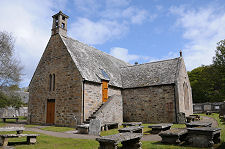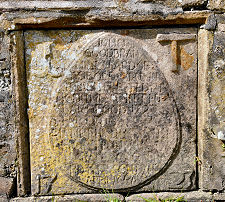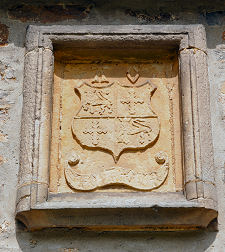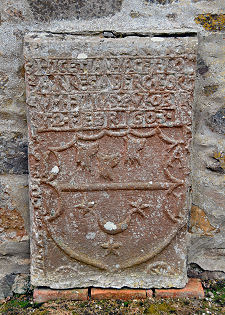 Cullen Old Kirk from the South-East |
Cullen Old Kirk, sometimes also referred to as St Mary's Collegiate Church, Cullen, stands half a mile to the south-west of the centre of Cullen, immediately to the east of Cullen House. It can be reached via minor roads, and though still close to the town, feels like it could be a million miles away. You know you've arrived when you find the car park, and from there it is a short walk down a walled lane to reach the kirkyard gate. The access from the east gives a strong impression it was designed in an era when the owners of Cullen House, the Earls of Seafield, wanted to keep churchgoers as far away as possible from their back yard. In the 1980s Cullen House was converted into eleven separate dwellings.
Cullen Old Kirk is pretty much all that remains of Old Cullen, the original settlement in the area. This was already in decline by the time the Earls of Seafield developed "New Cullen" and "Seatown of Cullen" in the 1820s, to take advantage of the pier built by Thomas Telford in 1819 and the abundance of fish in the local waters. It is difficult to believe today that to the south of the church once stood a tolbooth, a school, a mercat cross, and enough housing to support a thriving weaving industry. Cullen's relocation half a mile north-east was clearly good for the local economy; and was doubtless also good for the views from Cullen House.
The origins of the Church of St Mary of Cullen can be traced back to the mention of a church here in 1236. It isn't clear whether any of the structure on view today dates back this far, though it has been said that the shape of a blocked doorway in the south-east corner of the church suggests this part was built in the early 1200s.
On 27 October 1327 Queen Elizabeth de Burgh, the second wife of Robert the Bruce, died at Cullen Castle, and her "interiores partes" were buried in the church here. The remainder of her body was taken south for burial at Dunfermline Abbey. Robert, said to be "mad with mourning and woe", endowed a chaplaincy in Cullen to pray for her soul.
This was a precursor of what was to follow two centuries later when, in 1539, John Duff of Moldovet, built St Anne's Aisle on the south side of the church. Four years later the Church of St Mary of Cullen became one of 38 Collegiate Churches established across Scotland. The term "Collegiate Church" covered a variety of sins, often literally. Collegiate Churches were generally endowed by the the local laird, who paid for the maintenance of community (or "college") of priests. The primary role of the college was to pray for the souls of their benefactor, his wife, and his family.
The College at Cullen comprised a provost, six prebendaries or clergymen, and two choirboys. Evidence of this part of the church's life can be found in the form of the highly decorated aumbry, a niche in the north wall of the chancel. The ornate tomb of Alexander Ogilvie of Findlater and Deskford found in the kirk also dates back to this era, to 1554. The idea of Collegiate Churches was utterly alien to those driving the Reformation that swept across Scotland in 1560, so St Mary's Collegiate Church, Cullen, had an active life of just seventeen years.
After the Reformation the Old Kirk served as a parish church, and continues to do so today. The imposing laird's loft, now called the Seafield Loft, was inserted into the church in 1602, at the time the Ogilvies of Findlater (later to become the Earls of Seafield) abandon the ancestral home of Findlater Castle and moved their principal residence to the newly developed Cullen House.
Cullen Old Kirk benefits greatly from its depth of history. The building itself is attractive, and some of the detail unusual. And even if you visit on a day when you can't actually access the church itself (as we did), the old monuments and gravestones in the kirkyard, many set into the kirkyard wall, make it worth taking the trouble to find and visit.
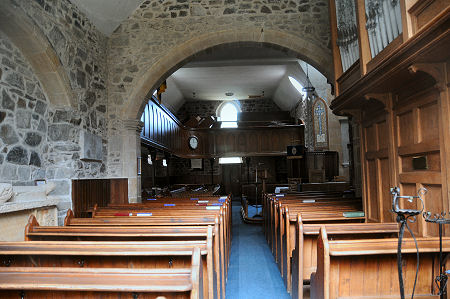 Old Kirk Interior: Through a Window |
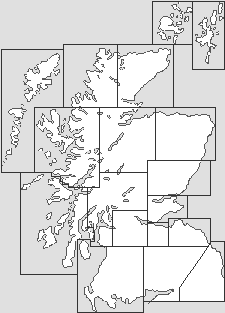
|
|
|
Visitor InformationView Location on MapGrid Ref:NJ 507 664 www.cullen-deskford-church.org.uk What3Words Location: ///rolled.revision.scoop |
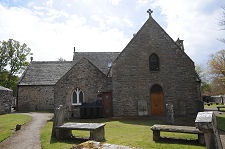 North Side of the Kirk |
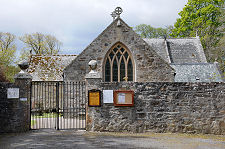 Old Kirk, and Kirkyard Gate |
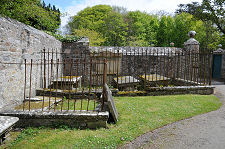 Kirkyard Enclosures |
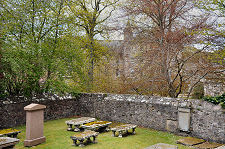 A Glimpse of Cullen House A Glimpse of Cullen House
|
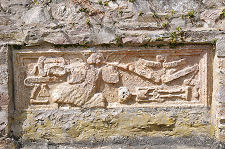 Old Gravestone Set into
Wall Old Gravestone Set into
Wall |
